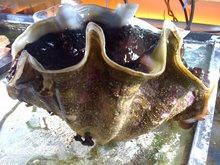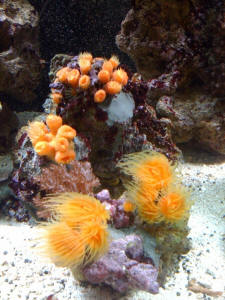|
FAQs about Behavior of Giant Clams, family
Tridacnidae
Related Articles: Got Tridacna? A beginner's guide to
keeping Tridacnid clams by
Laurie Smith, Example Chapter
from NMA Reef Invertebrates book, on Giant Clams, Tridacnids, A Brief Guide to the
Selection and Placement of Tridacnid Clams by Barry Neigut,
Tridacnid Health:
Pinched Mantle Syndrome in Giant Clams by Dr. David Basti,
Deborah Bouchard & Barry Neigut, Bivalves, Mollusks, Lighting Marine
Invertebrates,
Related FAQs: Tridacnids 1, Tridacnids 2, Tridacnids 3, Tridacnids 4, Tridacnid Clam Business, Tridacnid Identification, Tridacnid Behavior, Tridacnid Selection, Tridacnid Compatibility, Tridacnid Systems, Tridacnid Lighting, Tridacnid Placement, Tridacnid Feeding, Tridacnid Disease, Tridacnid Reproduction, Bivalves, Bivalves 2, Lighting Marine
Invertebrates,
|

|
I hope I did not speak too soon! Maxima Clam beh., Clownfish
comp. - 8/28/12
Hi Bob,
<Christine>
In my previous email I mentioned that my blue maxima clam and his BTA
friend were thriving in my aquarium. My clam has since left me
with a question. I hope I did not speak too soon. He was
approximately two inches when I purchased him about 8 months ago.
He has grown about a quarter of an inch since then, maybe more, but I am
sure less than a half of an inch.
<This family, species does grow slowly when small>
At the time I purchased him, I placed him inside a skeletonized half
shell of a much bigger clam that I purchased with some live rock.
I placed some substrate inside the empty half shell and placed the
little maxima clam on top. Within 24 hours he secured himself to
the shell and as far as I know has been happy as a clam ever since.
<Understandably>
Well last night he jumped shell. I found him this morning open and
beautiful, sitting in the substrate next to his old home. My first
thought was, well maybe he was outgrowing his home. My concern
came when I looked at the empty clamshell that he previously lived in.
I thought I saw the head of a feather duster worm, but upon closer
inspection it resembled a white muscle with a bunch of filaments
sticking out of it, and it was attached to the empty clamshell.
<Ohh...>
Well time to panic, right? Could this be his byssal filament?
<Yes>
Can clams leave part of it behind if they decide to move?
<Mmm, not usually>
If this is a serious problem, how long before he deteriorates, because he
still looks very colorful, is responsive opening and closing properly if
i wave my hand above him. He placed himself straight up, not on
his side or anything like that. He has not reattached himself to
anything yet, so i placed a large flat rock underneath him and the
substrate, because I really do not want him to attach himself to the
glass, I like to know that in an emergency I can relocate him if
necessary without injuring him.
<Good>
Perhaps what I saw attached to the empty clamshell was not even part of
my precious maxima. That is the best I am hoping for. OK I
just lied to you, the best I am hoping for is for you to tell me that
this is some form of asexual reproduction
<Not>
and soon I will have a another baby clam on my hands, but since I have
never run across that in any of my reading on clam care, I will chalk
that up to fantasy.
My major concern is that assuming the worst and he did leave part of his
byssal filament behind, is this normal? Can he survive it?
What are the signs of deterioration?
<Mmm, loss of responsiveness, colour...>
I have a sand sifting star, indigo dotty back, cleaner wrasse and four
clownfish. The clam is more than 6 inches away from the BTA.
Nothing that I can think of that would be picking on the maxima clam.
He is placed in the bottom of the tank where he is catching the spread
between a 10k led over the center of my tank and a 65k led on the left
side of my tank. As always, any advice would be greatly appreciated.
Incidentally Bob, if I do decide to remove a pair of my clownfish to
mate, perhaps causing the next dominant male to become female, would I
ever be able to add the clownfish back into my display tank or would
having two females cause a blood bath?
<If there's room, not usually a problem>
Thank you as always,
Christine K.
<Be of good cheer, Bob Fenner>
Re: I hope I did not speak too soon! 8/29/12
Bob thank you for your quick response. Just one more question if
you don't mind. If the clam is damaged in some way and will not
survive, how long of a deterioration process should I expect?
<Likely a few days>
In other words, when can I stop holding my breath?
<The same period>
It has been 24 hours and he looks/acts fine. If he makes it 48
hours, can I start to think he may survive?
<Yes>
Or is it more like weeks or months? I feel very confident that if
he secures himself to his new home within the next few days then I may
be out of hot water, but barring that scenario, if he continues to
look/act good, when can I start thinking we may have made it over the
hump, and besides watching him, is there anything else I can do?
<A boost (one time) in iodide-ate dosing is prudent. BobF>
Christine
|
Coral identification & gigas clam
shell formation question 9/23/08
WetWeb Staff,
First I just wanted to say thank you for providing such a
wonderful service.
<Welcome>
I just have two quick questions. First, regarding Dendrophyllia,
I purchased a few heads from two different online vendors and can
only positively identify one colony as Dendrophyllia. I suspect
that the second colony might be Tubastrea, but I am really not
sure. I was hoping that you wouldn't mind taking a look at
the picture attached and offer your best guess as to what the
second colony is. I know that the only true way to determine the
species is to examine the skeleton, but your best guess would be
greatly appreciated.
<The photo sent appear to be of the genus
Dendrophyllia>
My second question is concerning the growth of my gigas clam.
Once again, this was an animal acquired from an online vendor. I
have had it for just about 3 months now and it is doing fine. I
have noticed about a half inch
of new growth, but what concerns me is the unusual shape of the
shell. I'm guessing that since the clam is doing so well, I
really don't need to worry about it, but I am curious to know
if the growth pattern has a chance of
harming the clam as it grows larger. Pictures are attached for
your review.
<Not to worry... growth will slow, the shell change a bit
going forward>
Thanks in advance for your response, and thanks once again for
providing invaluable service.
Marc
<Again, welcome. Bob Fenner>
|
  |
Jumpy Clam 9/12/08
Hi,
I hope you can help me with a jumpy clam. It is a 2" Crocea. I got
it about a month ago. I have 2 other Croceas that I have had over a
year that have grown at least 2" each. I put the new one in about
the same lighting situation the others are in. I have a 250 MH light
& lots of rock.
All water tests perfect except nitrates just at .05.
<.05?>
My problem is that he starts to put his foot down & the light goes
on or off, a fish swims by or maybe I feed the fish & he jerks
& pulls the foot back in. About 95 % of the time he does this so
hard that he shoots right off the rock. Finally today I put him in a
small clear glass ramekin with sand and a small flat piece of coral
imbedded about 1/2 way down in the sand. My question is this how long
can he stay that way?
<A while considering all else is well.>
I tried to put the small piece of coral rock right under him but he
kept falling over into the sand, mantle down. I am at a loss as what to
do for this guy. I could see it if he wasn't happy with where he
was placed, but this jumping/flinching, I just don't see a way to
get around that.
What do you suggest??
<For the time being I would place him in the sand with the small
rock or even a shell beneath the clam. This will give it something to
attach to and a stable place to acclimate without jumping or falling
off. After a few weeks with all being fine, you can then place it
higher up, a bit at a time.>
So far he is still opening quickly after being moved and his mantle
opens quite far but I don't think that too much more of this will
be good.
<No, the constant moving and related stress will take its
toll.>
Thanks for any help or suggestions you might have
Tina Taylor
<Welcome, Scott V.>
|
|

